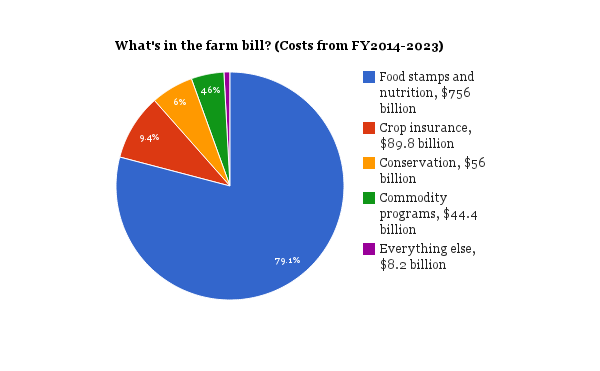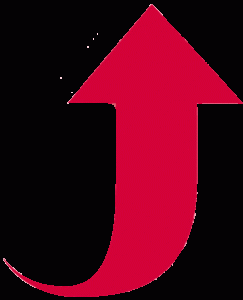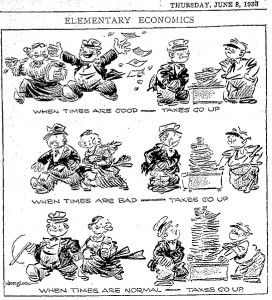by | ARTICLES, FREEDOM, GOVERNMENT, OBAMA, TAXES
Obama signed the Farm Bill into law.
This $956 billion bill will set the course of U.S. food policy for the next half-decade. The old farm bill expired in 2012, and its replacement is 959 pages long, costing some $956.4 billion over 10 years.
The chart below is courtesy of the WaPo.

This bill includes such goodies as:
— $3 million plan for Christmas tree taxes (15 cent levy per tree)
–$100 million will go to study how to get Americans to buy more maple syrup
–$1 million will buy weather radios for rural Americans
–$15 million ‘wool trust fund’
–$170 million program to protect catfish growers from overseas competition
But most of that money goes to food-stamp and nutrition programs, which are administered by the U.S. Department of Agriculture. The 10-year spending total for those entitlements will hit $756 billion under the new law.
Your tax dollars at work.
by | ARTICLES, ECONOMY, GOVERNMENT, OBAMA

The folks over at CNSNews reported that, according to the US Treasury, Public Debt has increased $6.666 Trillion during Obama’s Presidency.
The amount of debt listed on January 20, 2009 was compared to the amount of debt held January 31, 2014 — the most current day available. Those figures are $10,626,877,048,913.08 and $17,293,019,654,983.61, respectively.
That means the total amount of debt has gone up $6,666,142,606,070.53 under President Obama.
To put it into perspective, public debt first reached $6.666 trillion in July, 2003. CNSNews notes that in slightly more than 5 years, “the U.S. has accumulated as much new debt as it did in it’s first 227 years”.
Now, to make an entirely different comparision:
The public debt held by George W. Bush on the first day of his inauguration (Jan 20, 2001) was $5,727,776,738,304.64. On his last day full day in office, Jan 19, 2009, the debt was $10,628,881,485,510.23.
Therefore, debt during his 8 years increased $4.901 Trillion. One could also argue that debt went up some 85% during his term.
On the other hand, so far, Obama’s debt so far has increased 63% over 5 years.
If one were to take 85% and divide it by 8 years , one would find the average rate of debt increase to be 10.625% a year under Bush. For Obama’s debt to only increase by the rate of Bush’s, Obama’s debt percentage increase would be 53.125%. But Obama’s is more, currently at 63% debt increase — more than a year ahead of the average pace of Bush.
Taking Obama’s current rate of debt increase, 63%, and dividing it by 5 years, the average rate of debt incrase by Obama is 12.5% per year. At that pace, by the time Obama’s Administration is complete after 8 years, the debt increase will be 100.8%.
That means we can expect our Public Debt to increase by at least $10.711 Trillion, or that our public debt will be roughly some $21.337 Trillion at the end of his term. (This is only at the current rate of spending and debt, without taking into account future programs, etc)
In other words, it will have only taken 233 years to spend the first $10 trillion and roughly 8 years to spend the second $10 trillion.
by | ARTICLES, BUSINESS, ECONOMY, FREEDOM, GOVERNMENT

The story of “I, Pencil” is rightfully regarded as one of the most important economic essays of the 20th century. Known for both its brevity and simplicity, “I, Pencil” conveys the truth about the correlation between free people and economic freedom.
The brilliance of “I, Pencil” is that the lesson is told from the most unexpected perspective — that of the lowly pencil. Yet the very humbleness of the pencil is perfectly juxtaposed by the complexity through which the pencil itself comes into being.
Told through the eyes of the pencil, the pencil delightfully describes human ingenuity, cooperation, and connectedness — all necessary parts to bring the pencil to fruition. The pencil explains that it is a people free and unfettered, who have each learned and exchanged a skill, that ultimately will create a good — be it a pencil like him, or otherwise.
Ultimately, using the perspective of the pencil is a metaphor for Read’s salient point: for us all to look introspectively and understand ourselves, our potential, and the world in which we live and can contribute. That it is ultimately people, not some government, who can organize, work, and create a thing of beauty and of necessity.
In that regard, the recent movie adaptation of “I, Pencil”, produced by Competitive Enterprise Institute, fell short of its potential. To be sure, the film most certainly has beautiful and simple graphics to convey the story and show the complexity of markets. However, the message itself is narrated from an outside perspective explaining the process of creative industry using a pencil as an example, which is not how “I, Pencil” is written.
By choosing to retell “I, Pencil”, with a replacement narrator looking in instead of the pencil looking out, the film loses the charm of the story and the central message about individuals, their potential, and freedom to create. The story needs that foundation in order to powerfully and properly explain that people, not government, are the true source of economic freedom.
Though the film is good, it is not great, and misses a wonderful opportunity to really bring to life the message of “I Pencil”, and convey its truths about individual freedom and free markets. Start with the essay and then watch the movie — and be uplifted about the ingenuity of free people.



